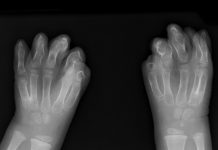Spinal stenosis is a condition that occurs when the spinal canal narrows and pinches the surrounding nerves. This pressure on the nerves can cause significant pain and discomfort.
According to the Mayo Clinic, the most common cause of spinal stenosis is related to the aging process.
Disc Degeneration – as you age, the gelatin like substance that separates your vertebrae can flatten or develop small tears.
When the disc protrudes, it often puts pressure on the nerves and can result in pain.
Osteoarthritis – Over time, the facet joints that are adjacent to your vertebrae can become worn down.
This can result in painful bone spurs and can be another factor in the narrowing of the spinal canal.
Symptoms of Spinal Stenosis
Spinal stenosis usually occurs in the lower back and neck area of the body. When it occurs in the neck, the following symptoms may be present:
- Neck pain
- Pain radiating into the shoulder and arm
- In severe cases, loss of bladder control
Symptoms of spinal stenosis in the lower back are:
- Lower back pain
- Pain and cramping in your legs
- Pain from standing typically eases after you sit down
- In severe cases, loss of bladder control
In either one of these cases, if you feel numbness or weakness in your extremities, you should report it to a doctor.
Treatment Options for Spinal Stenosis
Your first line of defense against spinal stenosis should be noninvasive procedures such as physical therapy, massage, acupuncture, and anti-inflammatory medications.
In persistent cases of spinal stenosis, surgery may be recommended. There are several surgical options that you can investigate with assistance from your physician..
Spinal Stenosis Exercises
Spinal stenosis exercises can help stretch the spine, while strengthening the supporting core muscles of your body. The following exercises will assist people with stenosis in the neck as well as the lower back:
Neck rolls
Sit in a straight back chair with both feet on the floor. Slowly bend your neck forward so that your chin is touching your chest.
Move your head from side to side and then backward. Hold each movement for 5 seconds and repeat this exercise 4 times.
Shoulder Blade Pulls
Stand straight with both arms at your side. Slowly pull your shoulders back as if you were trying to gently squeeze your shoulder blades together.
Hold this position for 15 seconds and repeat 4 times.
Lying Hamstring Stretch
Keep your back pressed against the floor and pull your leg straight until you fill a stretch in the back of your thigh.
Hold this position for 15 seconds and repeat with the other leg. Perform the stretch 3 times with each leg.
Double Knee Stretch
Lie on your back with both feet flat on the floor. Grab your legs and slowly pull both knees toward your chest.
When you feel a stretch in your lower back area, hold that position for 15 seconds. Repeat this movement 3 times.
Hands and Knees Stretch
Start by facing the floor with your hands and knees on the ground. Brace yourself by placing your hands under your shoulders with your arms straight out.
In this position, your back will be parallel with the floor. Tighten your abdominal muscles and gently arc your back towards the ceiling. Hold this position for 5 seconds.
After returning to the starting position, arc your back by pushing your stomach towards the floor. Hold this position for 5 seconds. Repeat this exercise 3 times.
Curl Ups
This exercise will assist in strengthening the abdominal muscles. Strong abdominal muscles will help stabilize your spine.
Start on your back with the both knees bent and your arms folded over your chest. Slowly raise your head and shoulders off the ground approximately 4 inches.
Hold this position for 3 seconds and lower your shoulders back to the starting position.
Perform 15 to 20 repetitions of this exercise, and as you gain strength, you can gradually increase the repetitions.
Considerations
Although spinal stenosis can be a painful condition, exercise and a healthy lifestyle can help combat the negative effects of this condition. If pain worsens during or after exercise, stop the activity and consult your doctor.
While spinal conditions are often limiting and disruptive, it is possible to maintain independence and live an active life. Travel can sometimes be difficult but many companies provide wheelchair accessible vehicles that enable users to transport themselves confidently and safely.













